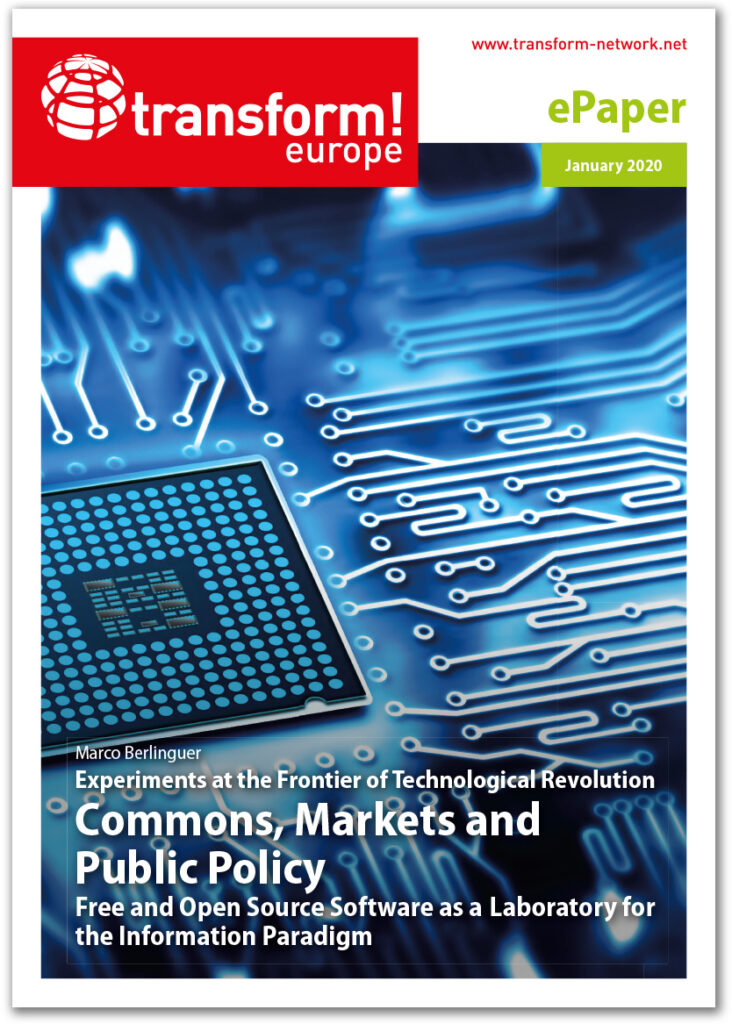Free and Open Source Software as a Laboratory for the Information Paradigm
The success of Free and Open Source Software (FOSS) is a phenomenon that has not still been adequately studied and elaborated in economical and political theory. Yet FOSS has proved to be a laboratory of social, economical and institutional innovations that seem to have a great relevance for the informational paradigm.
Not only did FOSS emerge in the software, that is in the core technology of the ICT revolution, and is about to become the standard model of production in this industry, but its innovative arrangements have also inspired emulations in many other domains.
The most distinctive feature of FOSS is that it is organized around a commons: that is, a resource that is governed by licenses which allow anyone to access, use, copy, modify, develop and redistribute the software. This characteristic has many important implications in the modalities of governance and in the forms of generation and appropriation of value.
FOSS is the clearest evidence of the potential role that new types of common goods are about to play in the emerging digital networked economy and society. Similarly, its surprising trajectory sheds new light on the newly established field of study that has developed around the rediscovery of the notion of the commons in recent decades.
In this sense, while the first wave of studies on the commons has been engaged around the definition of the commons as an autonomous sphere distinct from the market and the state, the evolution of FOSS indicates the importance of studying the governance of these new commons within hybridconfigurations, as for example in their modulation with markets.
The successful integration of FOSS in the market and in the capitalistic competition requires a review of the first approaches to this model of production. For example, the experience has shown that FOSS can be used to strategically achieve new forms of centralization and concentration of power and value. Likewise – despite its idiosyncratic form, which does not allow any form of exclusive appropriation – FOSS has demonstrated that it can expand in parallel with newmarkets.
In order to visualize the relationships between FOSS and markets, a syntheticframework is proposed, that is organized through three concepts: semi-commons, infrastructures and ecosystems generation. Each allows to visualize a different way to modulate a multi-layered structure of regimes of property and value production and appropriation.
While the transition to FOSS in the market is consolidating, public administrations and public policies are still struggling to find a way to engage productively with this new model of technological development and production.
Publicpolicies promoting FOSS have begun early and have not been few. Yet so far no clear model has emerged and the setbacks have not been few.
The rationales for the public administrations to support the use and development of FOSS are both economical and political, as FOSS promises to reduce costs and risks, and increase independence and transparency in the management of critical resources, services and infrastructures.
Public policies so far have underestimated the obstacles generated by the legacies of the past, the lock-in mechanisms produced by the integration of ecosystems of hardware and software producers in previous proprietary platforms and the fragmentation of alternative solutions, undervaluing the costs of integration and maintenance of isolated systems in an environment of hardwares and softwares extremely dynamic.
However, a reversal of the trend is taking place, as FOSS is becoming the new standard approach on the frontiers of innovation (Cloud, Internet of Things, Data centers, Artificial Intelligence, Blockchain). As a result, a strong trend towards its use and development in public policy is spreading worldwide. Hundreds of public organizations are currently engaged in a process of practical learning by doing in FOSS development.
As FOSS will play a central role in the new generation of software services, public administrations should not overlook the risks of new traps and dependencies. Even more so, as the FOSS ecosystem has entered a consolidation phase.
EU policy based on abstract principles such as technological neutrality, open standards, impartiality in public procurement has proved difficult to apply and ineffective in preventing the capture of public administrations by private monopolies and lock-in strategies by suppliers.
The increasing role of FOSS in the provision of critical infrastructure and its maturation as a production system will push furtherinstitutional innovations in the FOSS ecosystem. One of the most important areas of innovation could come precisely from a greater involvement of public actors.
Three directions can be glimpsed as emerging fields of innovation in public policies:
– An active policy of standardization, as a lever for governance and productivity generation;
– The modulation of mixed forms of governance blending state, market and commons based mechanisms;
– The development of new forms of public-public cooperation.
TABLE OF CONTENTS
ACKNOWLEDGMENTS 4
EXECUTIVE SUMMARY 5
1. INTRODUCTION 7
1.1 A surprising phenomenon 7
2. THE EVOLUTION OF FREE AND OPEN SOURCE SOFTWARE 10
2.1 Free software 10
2.2 Open source software 11
2.3 Unexpected successes in the private sector 12
3. LESSONS ON THE NEW COMMONS 15
3.1 Reconsidering the relationship between commons and markets 15
3.2 A framework for analyzing hybrids 15
3.3 A new research agenda 16
3.4 Free and open source software as an exemplar in the emerging paradigm 18
4. PUBLIC POLICY AND FREE AND OPEN SOURCE SOFTWARE 22
4.1 The state of the art: Some data 22
4.2 The reasons 24
4.3 The policies: An overview 25
4.4 Limited results and barriers to adoption 27
5. PATH DEPENDENCE, BREACHES AND THE BREAKTHROUGH 29
5.1 Microsoft: The invincible monopoly 29
5.2 The revenge of free and open source software 32
5.3 The new scenario 34
6. A NEW PUBLIC POLICY AGENDA 36
6.1 New trends and developments 36
6.2 Governance by standardization 37
6.3 Mixed forms of governance 38
6.4 Digital (post-)sovereignty 40
7. CONCLUSION: LOOKING FORWARD 43
7.1 FOSS as a laboratory for future public policy 43
8. BIBLIOGRAPHY 45
